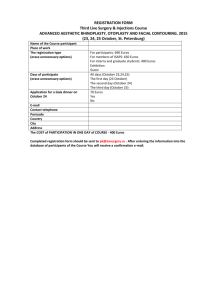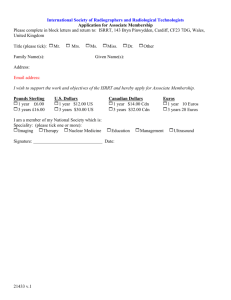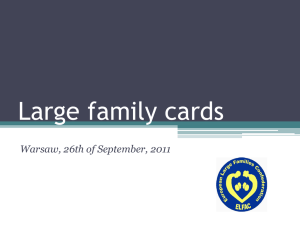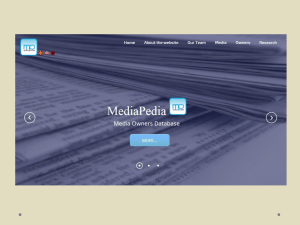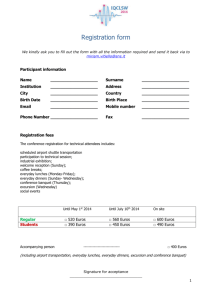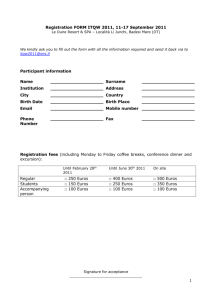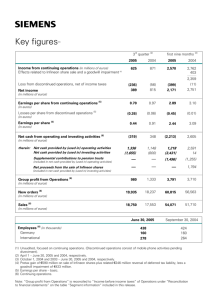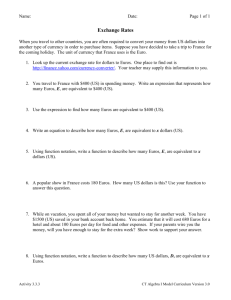Erläuterungen zur Konzern-Gewinn- und Verlustrechnung
advertisement
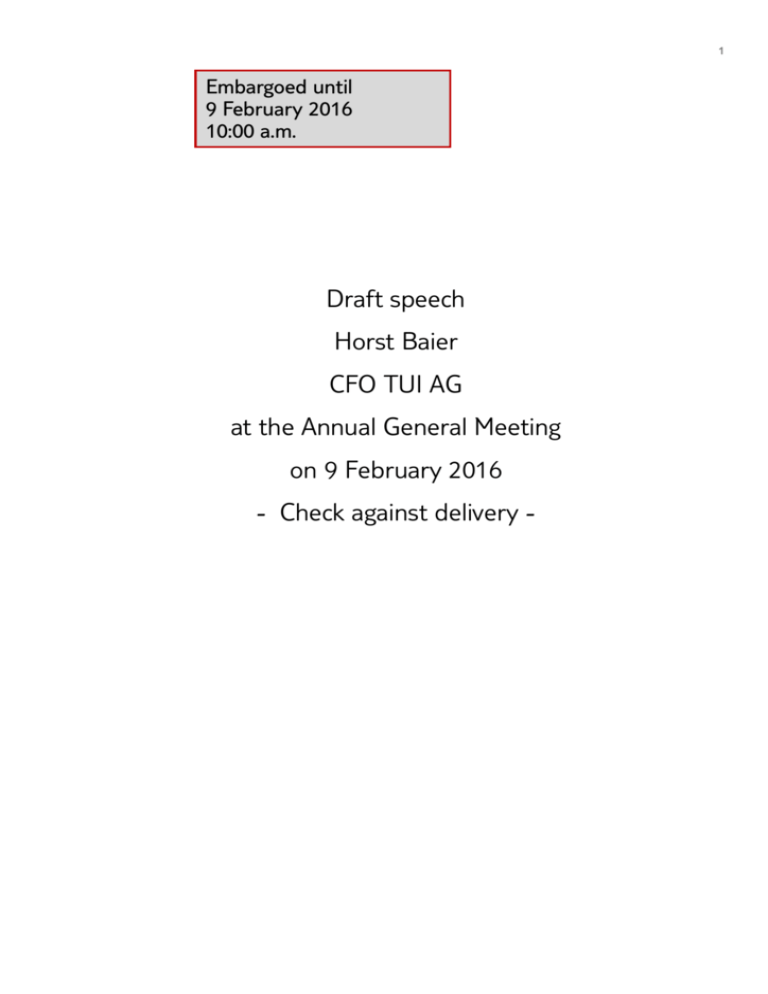
1 Embargoed until 9 February 2016 10:00 a.m. Draft speech Horst Baier CFO TUI AG at the Annual General Meeting on 9 February 2016 - Check against delivery - 2 Thank you very much, Mr Joussen. Good morning, Ladies and Gentlemen, Following Mr Joussen’s presentation of our operating performance in the completed financial year 2014/15, let me now explain to you how this has been reflected in TUI Group’s income statement and statement of financial position. Chart 2: Highlights FY 2014/15 Let me first of all present the development of our key indicators before taking you through the reported numbers in our income statement. TUI Group’s turnover rose by around 8 per cent to 20.0 billion euros in financial year 2014/15. Excluding foreign exchange effects, resulting in particular from the rise in sterling against the euro, turnover increased by around 4 per cent, more than the customer numbers of our tour operators, which were up by around 2 per cent versus the prior year. TUI Group’s underlying EBITA grew by around 23 per cent year-onyear in financial year 2014/15. Excluding the positive foreign exchange translation effects, which also mainly resulted from the rise in sterling, it grew by 15.4 per cent, slightly outperforming our earnings guidance of 10 to 15 per cent. As Fritz Joussen has already 3 outlined, this gratifying performance growth was above all driven by Northern Region, Hotels & Resorts, and Cruises. Despite an increase in one-off expenses, in particular due to the integration of our business after the merger with TUI Travel, our good operating performance also resulted in a notable increase in reported EBITA in financial year 2014/15 of around 11 per cent. As we carried on working to reduce Group debt, our interest result continued to improve. Moreover, we significantly cut our income tax expenses in the completed year by forming a fiscal entity for income tax determination in Germany. We therefore recorded a considerable increase in our Group profit, i.e. earnings after tax, of around 40 per cent year-on-year. Due to the acquisition of cruise ship Europa 2 in the period under review and the financing of seven new aircraft through finance leases, TUI Group again posted a low net debt of 214 million euros at the end of the financial year, as expected. In the previous year, we had a net cash position of 293 million euros. The net debt carried as at 30 September 2015 was also impacted by a foreign exchange effect worth around 127 million euros, driven by the rise in sterling mentioned earlier. The ongoing increase in our operating profitability, the decline in interest payments and the delivery of merger-related tax synergies 4 resulted in a significant increase in earnings per share. I will explain underlying earnings per share in greater detail in a moment. However, let me first of all take you through the key developments in our income statement. Chart 3: Income statement 2014/15 In reporting the operating performance of our segments and the Group, we focus on underlying EBITA – i.e. earnings before interest, taxes and goodwill amortisation. Underlying EBITA by the Group totalled 1,069 million euros for the period under review, up by around 200 million euros year-on-year. Underlying EBITA does not include special one-off income and expenses of 204 million euros on balance as they are not part of the Group’s operating performance. 5 Chart 4: Adjustments The increase in adjustments for one-off expenses of around 111 million euros is mainly attributable to integration costs of around 47 million euros from the merger between TUI AG and TUI Travel. These costs include an amount of around 31 million euros for the rationalisation of the corporate head office and around 16 million euros for the planned integration of incoming agencies into the Source Market organisations. These expenses were included in the budget for the new TUI Group. They create the basis for the delivery of the merger-related synergies. Adjustments for the previous financial year 2013/14 had also included an amount of around 81 million euros for the reduction in pension obligations which did not repeat in the period under review. Other adjustments for the period under review related to purchase price allocations of around 76 million euros and in particular expenses for the synergy project OneAviation for our airlines and for restructuring schemes in Germany, Benelux, the Nordics and Hotelbeds Group. Moreover, Hotels & Resorts carried adjustments for impairments on input tax receivables in an Italian subsidiary and transfers to provisions for a pending litigation in connection with the purchase of a Turkish hotel. Chart 5: Income statement 2014/15 6 Reported EBITA including the special one-off items mentioned above totalled around 865 million euros, an increase of around 11 per cent year-on-year. The decline in net interest expenses of around 40 million euros yearon-year to 184 million euros results from changes in the structure of our financial debt. In financial year 2014/15, all convertible bonds were fully converted into equity. Accordingly, the interest expense for convertible bonds declined by around 96 million euros, partly offset by interest expenses [of around 14 million euros] for the high-yield bond issued by TUI AG in September 2014 and additional interest expenses for the acquisition of Europa 2 and finance leases for new aircraft. In the financial year under review, an impairment test of our investment in Hapag-Lloyd AG resulted in a reduction in fair value versus the cost to acquire the stake. We therefore wrote our investment down to its fair value of around 335 million euros through profit and loss. The impairment of around 147 million euros was carried in financial expenses. The increase in TUI Group’s operating profitability, the mergerrelated increase in one-off expenses, the lower interest expenses and the expense for the measurement of our investment in Hapag-Lloydresulted in an improvement in Group earnings before tax of around 36 million euros to around 535 million euros. 7 In 2014/15, our tax expenses declined by around 126 million euros versus the prior year. This is primarily attributable to the mergerrelated revaluation of deferred tax assets on loss carryforwards. Moreover, our underlying income tax rate also fell to 25 per cent, as announced, due to the simplification of our Group structure. The result from discontinued operation shows the after-tax result of LateRooms Group. In the past financial year, we took the strategic decision to exit LateRooms Group as it does not play a role in our tourism strategy. After we had already closed down the operating businesses of AsiaRooms and Malapronta in the second and third quarters of 2014/15, we completed the disposal of LateRooms Group in October 2015. This takes me to Group profit, which totals 380 million euros, up 40 per cent year-on-year. In order to offer you meaningful information about earnings per share, we refer to earnings from continuing operations. They do not include the loss from the discontinued operation and totalled around 448 million euros in the completed financial year. Following the deduction of the shares of non-controlling interests in Group profit and the interest payable on the hybrid bond, the Group reports earnings per share of 77 cents for its continuing operations for the completed financial year. 8 To enhance comparability, we have established underlying earnings per share, eliminating one-off effects from the conversion of our convertible bonds into equity and from the merger between TUI AG and TUI Travel. These underlying earnings per share grew by around 31 per cent to 98 cents year-on-year. Following my comments on the income statement, please allow me to say a few brief words about the consolidated statement of financial position and the development of our Group’s net debt. Chart 6: Financial position as at 30 September 2015 The Group’s balance sheet total grew by 1 per cent year-on-year to 14.1 billion euros. The main driver was the acquisition of Europa 2 and the investments in our aircraft fleet. Our equity ratio stood at 17.2 per cent as at 30 September 2015, slightly down on the previous year. Chart 7: Net debt as at 30 September 2015 Since financial year 2009/10, the reduction in our stake in HapagLloyd and the cash flow focus of all Group entities, in particular, have resulted in a significant reduction in TUI Group’s net debt of 2.1 billion euros. Due to the acquisition of Europa 2 in the period under review, the financing of seven new aircraft through finance leases and the increase in the sterling exchange rate, TUI Group achieved a further 9 reduction in its net debt in financial year 2014/15, as expected, to 214 million euros. We regard our Group’s financial stability and flexibility as a key prerequisite for the further development of TUI Group. In response to the merger between TUI AG and TUI Travel, Standard &Poor’s and Moody’s lifted their TUI ratings. We are aiming to achieve further improvements in order to secure sufficient access to debt capital markets, even in challenging macroeconomic situations, and further optimise our financing costs. In order to document this objective, we have defined a Financial Policy, which comprises binding target corridors for the financial stability indicators leverage ratio and coverage ratio. Chart 8: Dividend proposal for FY 2014/15 Let me now explain our dividend proposal for the completed financial year: In the framework of the merger between TUI AG and TUI Travel PLC we had announced that our dividend was to grow in line with the growth of the new Group’s underlying earnings on a constant currency basis. We also announced our intention to pay an additional bonus of 10 per cent on the base dividend in respect of the completed and the current financial year. The dividend proposal is based on the dividend last paid by TUI Travel before the merger, accounting for 0.445 euros per TUI AG share. The strong earnings growth of 15.4 per cent (on a constant currency basis) and the additional 10% bonus on the base dividend thus result in our dividend proposal of 56 cents per share. Compared with the dividend 10 of 33 cents per share paid by TUI AG for the previous financial year, this is an increase of around 70 per cent. So much for my comments on the financial statements for financial year 2014/15. Let me now turn to the current development of our business in Q1 2015/16. 11 Chart 9: Highlights Q1 2015/16 Earlier today we published our Q1 results on our website and held a conference call to explain our business performance to the capital market analysts. TUI Group has delivered a successful start to the Winter season 2015/16. In Q1, the Group’s brand turnover totalled around 4.4 billion euros, up by around 7 per cent (or around 4 per cent, respectively, on a constant currency basis) year-on-year. TUI Group’s seasonal operating loss (underlying EBITA) decreased by around 3 per cent to minus 102 million euros in Q1 2015/16. At minus 164 million euros, the seasonal Group loss rose by 28 million euros year-on-year. While the Group’s net interest expense continued to decline, we carried out an additional non-cash writedown on our investment of around 43 million euros due to the current share price development of the Hapag-Lloyd share. Please bear with me for mentioning, once again, that due to the seasonal swing in tourism, the first two quarters of any one year generate negative profit contributions, which are significantly offset in the “strong” Summer quarters (Q3 and Q4). Chart 10: Source Markets and Hotels & Resorts 12 Let me now present the development of earnings by our segments in greater detail. The seasonal operating loss of the Source Markets increased slightly by 4 million euros versus the prior year. While our tour operators in Northern Region achieved a further improvement in their results, Central Region recorded a slight decline driven by the continued challenging trading conditions in Germany. Western Region also saw its results impacted by higher marketing costs in relation to the TUI rebranding in the Netherlands, which will balance out in the course of the year, and the one-off positive effect delivered in Belgium in the prior year. Hotels & Resorts posted an operating result of 25 million euros in the first quarter of 2015/16. Taking account of the book profit from the sale of a Riu hotel worth around 16 million euros included in the prior year reference quarter, this constitutes an improvement in the operating performance of around 12 million euros, primarily attributable to strong demand for our Riu hotels in the Canaries and the Caribbean. 13 Chart 11: Cruises and Specialist Travel Underlying earnings by the Cruises segment reflect the good business performance in the first quarter of 2015/16, with an improvement of around 6 million euros versus the prior year. Thanks to its fleet expansion, TUI Cruises strengthened its competitive position and continued to deliver a good performance in the first quarter, as did Hapag-Lloyd Cruises. The new Mein Schiff 4 operated by TUI Cruises has been particularly well received by the market. By contrast, we are not satisfied with the performance of Specialist Group, whose seasonal loss (underlying EBITA) increased to around 32 million euros in the first quarter of 2015/16. The reasons for that development included the weaker skiing holidays business caused by poor snow conditions, the decline in demand for adventure tours due to geopolitical uncertainty, and the weaker performance of our US specialist tour operators. Overall, TUI Group has started off very well into the new financial year despite the current geopolitical headwind. Fritz Joussen had already explained to you that the current situation also impacts trading for the upcoming Summer season. Demand for destinations in North Africa and Turkey has fallen year-on-year in all Source Markets. At the same time, however, we are recording strong current trading for alternatie destinations, which will also have a positive effect, in particular, on earnings by Hotels & Resorts. Overall, we are 14 therefore very confident that we will achieve our targets for the full financial year 2015/16. Let me now explain our outlook for the current financial year 2015/16 in greater detail. Chart 12: Our targets for FY 2015/16 The guidance presented in our Annual Report 2014/15 regarding the expected development of TUI Group in financial year 2015/16 is upheld unamended. Please allow me to share some technical information with you: The translation of the income statements of foreign subsidiaries in our consolidated financial statements is based on average monthly exchange rates. TUI Group generates a material part of Group turnover and a high proportion of our profits and cash flows in currencies other than the euro, in particular pound sterling, US dollar and Swedish krona. Taking account of the seasonal swing in tourism, the development of the exchange rates of these currencies against the euro therefore strongly impacts the financial indicators shown in TUI AG’s consolidated financial statements. The following comments on the expected development of our Group in financial year 2015/16 are therefore based on assumed constant currencies for the completed financial year 2014/15. 15 Brand turnover: A major part of our future turnover growth will arise from joint ventures, measured at-equity in our consolidated financial statements. The turnover generated by these companies, including in particular TUI Cruises and Canadian tour operator Sunwing, is therefore not part of TUI Group turnover. So we have introduced the indicator “brand turnover” to provide a transparent presentation of the turnover generated by our joint ventures. In financial year 2015/16 brand turnover is expected to grow by at least 5 per cent on a constant currency basis. Turnover: In financial year 2015/16 we expect turnover to grow by at least 3 per cent on a constant currency basis, in particular driven by an expected increase in customer numbers for our high-volume tour operators due to the implementation of our growth strategy. Underlying EBITA: We expect underlying EBITA to grow by at least 10 per cent in financial year 2015/16 on a constant currency basis due to the implementation of our growth strategy. Risks relate to the development of customer numbers against the backdrop of continued economic environment volatility in our major Source Markets, demand for our own hotels and cruise ships, and the delivery of post-merger synergies. Ladies and Gentlemen, 16 By way of conclusion, let me briefly comment on the proposed authorisations relating to capital procurement in line with agenda items 6 to 8 and the acquisition and use of own shares under agenda item 9. Chart 13: Agenda items 6 to 9 TUI AG’s share capital more than doubled in the completed financial year due to the merger between TUI AG and TUI Travel PLC and the conversion of outstanding convertible bonds into shares in the Company. It currently totals around 1.5 billion euros. Against this backdrop and in the light of the fact that some authorisations have expired or will expire in the near future, we have submitted proposals for new authorisations relating to capital procurement measures, which were already customary at TUI AG. This will enable the Company to retain the planning security it needs to adjust its equity resources quickly and flexibly in line with financial requirements. The proposed authorisations under agenda items 6 to 9 are of a merely precautionary nature and serve to secure our financial scope for action. Should the resolutions be used in future, the balance sheet ratios would at any event be taken into account in order to minimise overall capital costs. Under agenda item 6 we ask the Annual General Meeting for its approval of authorised capital authorising the Executive Board to increase the share capital of the Company, subject to the consent of 17 the Supervisory Board, by issuing new registered shares in return for cash contribution by up to 150 million euros, i.e. almost 10 per cent of the current share capital. Shareholders’ pre-emption rights may be excluded if the issue price of the new shares is not substantially lower than their market value. Under agenda item 7 we ask the Annual General Meeting for its approval of additional authorised capital. The Executive Board is to be authorised to increase the share capital of the Company, subject to the consent of the Supervisory Board, by issuing new registered shares in return for cash or non-cash contribution by up to 570 million euros, i.e. nearly 38 per cent of the current share capital. Shareholders’ pre-emption rights may be excluded in particular by a maximum aggregate amount that may not exceed 20 per cent of the share capital (around 300 million euros) if the capital increase against non-cash contribution is effected in the form of companies, investments or other assets. Under agenda item 8 we ask the Annual General Meeting for its approval of new conditional capital of up to 150 million euros authorising the Executive Board to issue new bonds, subject to the consent of the Supervisory Board, of a total nominal amount of up to 2 billion euros and to issue up to 58.7m new registered shares to the creditors or bondholders to serve the resulting conversion or warrant rights. Shareholders’ pre-emption rights may be excluded for the bonds. 18 The three proposed resolutions will authorise the Executive Board to issue shares of up to a maximum of around 58 per cent of the current share capital, including 48 per cent for authorised capital and 10 per cent for conditional capital. Should you approve today’s proposed resolutions, the existing authorisations will be replaced by the new ones. On the basis of the overall framework defined by the German Stock Corporation Law, a term of 5 years each has been proposed for the three global authorisation resolutions. A shorter term would be allowed by law; however, taking account of the need to include the authorised and conditional capital in the Charter and considering the intent and purpose of the authorisations, this would be less practical and ultimately disadvantageous for the Company. Shareholders will be protected as the use of the authorisations by the Executive Board requires the consent of the Supervisory Board. Without new authorisations granted at subsequent Annual General Meetings, the authorisation volume outlined above, the 20 per cent limit on the issue of bonds against non-cash contribution excluding pre-emption rights and the 10 per cent limit on the issue of bonds against cash contribution excluding pre-emption rights apply for the five-year term (and are not annual limits). Let me give you an example to illustrate this. Implementation of a capital increase in return for cash contribution in line with item 6 of the agenda, with the exclusion of shareholders’ pre-emption rights, would have the consequence that the 19 authorisation of a capital increase in return for non-cash contribution in line with agenda item 7 would be reduced from 20 per cent to a maximum of 10 per cent of the share capital, and that it would not be possible to issue bonds excluding shareholders’ pre-emption rights in line with agenda item 8 without a new resolution adopted by the Annual General Meeting. Under agenda item 9, we ask the Annual General Meeting to adopt a resolution to aquire and use own shares. The term of the authorisation will again be 18 months; however, any contract to purchase own shares must be concluded before the 2017 Annual General Meeting. The authorisation to acquire own shares granted by the 2015 Annual General Meeting has not been used so far. The Company does not hold any own shares. The new authorisation is designed to grant the Company the opportunity to acquire own shares of up to 5 per cent of the share capital, however at most 29.3 million shares, via the stock exchange or a public offer to all shareholders. In any event, the principle of equal treatment enshrined in the German Stock Corporation Act has to be observed. The acquired shares may be cancelled or sold over the stock exchange or used subject to the exclusion of pre-emption rights, however, observing a voluntary limit of up to 10 per cent of the current share capital. At present, the Executive Board does not intend to make use of the authorisations proposed in line with agenda items 6 to 9; however, 20 should the Annual General Meeting approve the proposed resolutions, the Executive Board will review the option to use the instruments from time to time. The Executive Board will only exercise the authorisations to issue shares, bonds or use own shares with the exclusion of pre-emption rights if the strict requirements for the exclusion of pre-emption rights stipulated by the German Stock Corporation Act are met in the specific situation and, in particular, if the exclusion of pre-emption rights is considered to be in the best interests of the Company and its shareholders. We ask you for your approval of the proposed resolutions. Thank you very much for your attention.
